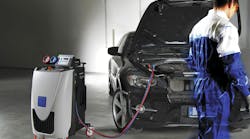In a recent New York Times op-ed, U.S. Senate Minority Leader Chuck Schumer (D-NY) revisited the latest version of “Cash for Clunkers,” previously known as the Car Allowance Rebate System (CARS), a vehicle retirement program implemented by the Obama Administration in June 2009. Originally sold to the public as an “eco-friendly stimulus” initiative whereby the government buys up older, high-polluting vehicles, post-clunker White House reports clearly indicated that the program was about selling vehicles and not necessarily related to improving the environment. More on this later; back to Senator Schumer’s efforts.
Sen. Schumer has proposed “to rapidly phase out gas-powered vehicles and replace them with zero-emission, or “clean,” vehicles like electric cars. The goal of the plan, which also aims to spur a transformation in American manufacturing, is that by 2040 all vehicles on the road should be clean.” Sen. Schumer went further and described how this initiative would unite labor, automakers and environmental groups. Missing from this list, similar to their exclusion in the 2009 Obama objective, is the U.S. automotive aftermarket. By the Senator’s own estimates, this project will cost $454 billion over 10 years.
Although legislation has not been introduced to date, U.S. Sen. John Barrasso (R-WY) countered with his own op-ed: “He wants to get every gas-powered car off the road and to resurrect President Barack Obama’s disastrous “Cash for Clunkers” program. That program wasted $3 billion of taxpayer money giving subsidies to people who bought newer vehicles. Even environmentalists admitted that it had “slim if any environmental benefits.” Mr. Schumer’s “new” plan is 100 times more expensive. He wants to spend $392 billion of taxpayer money to subsidize cars only wealthy Americans can afford.
“The median price for electric vehicles is roughly $20,000 more than the median price of gas-powered cars. Sold as stimulus, the first program was actually a drag on the economy. While the effect on taxpayers was significant, the effect on the air was minimal. Mr. Schumer’s plan doubles down on failure.”
The concept of retiring older vehicles has been around for some time. Princeton University’s Dr. Allen Blinder profiled the issue in a 2008 New York Times editorial. Dr. Blinder described cash for clunkers as a trifecta:
- A cleaner environment
- More equal income distribution
- An effective economic stimulus
A less emphasized result of Dr. Blinder’s proposal was that it would result in more new vehicle sales, which at the time would impact an ailing automotive economy. What was clearly left out was an administration that ignored the automotive aftermarket. The 2009 Cash for Clunkers program cost independent repairers lost sales and fewer parts purchased for these older vehicles taken out of the marketplace impacting both distributors and aftermarket manufacturers.
In the Obama Administration’s Council of Economic Advisor’s analysis of their Cash for Clunkers program, they focused on Dr. Blinder’s muted fourth reason as to why to have a Cash for Clunkers program — the increase in sales of new vehicles. According to the White House analysis, “A plausible interpretation of the available data, in fact, is that many of the CARS sales were to the kinds of thrifty people who can afford to buy a new car but normally wait until the old one is thoroughly worn out. Stimulating spending by such people is very nearly the best possible countercyclical fiscal policy in an economy suffering from temporarily low aggregate demand.” Where was the analysis of the impact on the automotive aftermarket?
The Automotive Service Association opposed Cash for Clunkers, and after it was clear the program was moving forward, highlighted options for the Administration to consider:
- Include a vehicle repair option for consumers.
- Programs should be administered by the states.
- Vehicle participation should be tied to emissions and improving air quality.
- Repair cost allowances should be sufficient to address emissions repairs.
Cash for Clunkers is a bad idea. It did not succeed during the Obama Administration and should not be considered by the 116th Congress.

